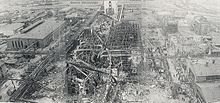Chemical accident in Bitterfeld
The chemical accident in Bitterfeld was one of the most serious industrial accidents in the GDR . After a vinyl chloride - Explosion in electrochemical Bitterfeld on 11. July 1968 42 people were killed, over 270 were injured.
Chronology of the accident
On the morning of July 11th, workers in the Bitterfeld Electrochemical Combine (EKB) discovered leaks in one of the twelve autoclaves for PVC production. During the morning shift it was not possible to repair the leaked areas, which is why the autoclave, which was already filled with 4 t, was emptied in order to replace a seal on the pressure gauge . Despite the narcotic effect, it was a common practice to vent gaseous vinyl chloride in such cases.
At 2:02 p.m., the gas exploded. In Muldenstein , a community 6 km away, window panes broke. Of the 57 workers in the PVC hall, 42 were killed instantly, and over 270 other people were injured when the detonation wave damaged and destroyed large parts of the combine.
At risk to his life, worker Peter Krüger was able to prevent the other filled autoclaves from exploding in the rubble field, which prevented even greater damage. In addition, tank wagons filled with vinyl chloride, which also threatened to explode, could be removed from the siding or cooled.
Because of the continued leakage of vinyl chloride, cutting torches could not be used for three days; the rescue work of the rescue teams had to be carried out with bare hands and simple equipment.
The explosion caused direct damage of around 120 million GDR marks. The indirect damage from production losses and imports from the non-socialist economic area amounted to around one billion GDR marks. After the accident, the plant was not rebuilt; instead, production was completely relocated to Schkopau to the Buna Combine . The EKB ( Elektrochemisches Kombinat Bitterfeld ) received only very little funds for the modernization of the other parts of the company, some of which were quite ailing.
consequences
After the accident, the regulations on occupational safety and fire protection in the GDR were significantly tightened, which subsequently led to ten new ordinances by 1971. This chemical accident led to a rethink that not only the production plan has to be adhered to, but that ecological issues are important in addition to occupational health and safety and fire protection . The state culture law passed in 1970 resulted from this knowledge . Nevertheless, there were still large numbers of incidents in the following years, often triggered by the wear and tear of production systems. The investigations by the public prosecutor's offices often revealed negligence and indifference as the cause of accidents .
monument
On July 11, 2019, a memorial was inaugurated that is two meters high and bears the name of the people who died in the accident.
Movie
- The big bang - Bitterfeld 1968 , MDR documentation from the series Forgotten Catastrophes , 1999
See also
Individual evidence
- ↑ a b Michael Zschiesche: The air - a gas field. Article in Friday of November 30, 2001 about average accidents and industrial accidents in the GDR

